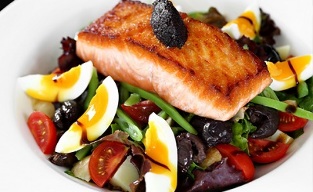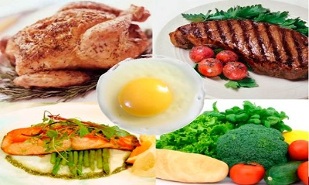How many times have you had to reread so many highly effective diets that help remove subcutaneous fat? Do you know why in the world there are more than 10, 000 options for different activities to lose weight? It's simple: because 90% of them are ineffective. A protein diet for weight loss is a good choice, but it can also be ineffective if used incorrectly. How to use protein for weight loss without harming health with maximum results?
How to lose weight with protein diet?
To get rid of the subcutaneous fat layer, you need to know your body's physiological needs, understand when to consume carbohydrates and when to consume protein, and be able to listen to the body to give a multitudereminder, in case we make the wrong diet.
Surely most of you already know that if you limit your intake of MSG and complex sugars, you can lose significant weight, the specific number depends on the percentage of fat in the human body. This can be called a low-carb diet, which is a very effective way to get rid of fat. Deficits are created by minimizing the amount of carbohydrates that are adequately replenished with fat. That is why people are losing weight by limiting the use of carbohydrates in their diet.
What if we completely remove carbohydrates from our diet?
Do we have a better way to lose weight? Our answer: of course, yes. This diet was especially popular during the heyday of bodybuilding and was widely promoted by Vince Gironde. You just need to look at his photo and instantly know why he recommended it. According to many nutritionists, an effective fat burning method is the protein diet.

The protein diet for weight loss is a carbohydrate-free diet that includes only protein products and healthy fats for the body. Carbohydrate calories are fully compensated for by animal protein. This method not only allows the removal of fat as efficiently as possible, but also speeds up the metabolism and conserves muscle tissue as much as possible.
Many practical diets do not take into account the last two aspects: their main goal is to simply reduce the total daily caloric intake, which does not have a positive effect on one's condition. weight loss.
The drastic drop in calories is considered a life-threatening threat by the body, which begins to slow down metabolism and transport all consumed food into subcutaneous fat, using muscle fibers for consumptionenergy. So it turns out that at the end of this method of weight loss, one creates the ideal conditions for fat gain and everything to burn muscle mass. We hope that now you've lost the desire to try the famous mono diets?
Basic principles of the protein diet
When we create a completely carbohydrate-free environment, ketones begin to be released from the subcutaneous fat layer, which is the main source of energy for the brain and nervous system.
To clarify, it must be explained that all the foods we eat contain more or less three nutrients and each one performs its own function to support the life of the body. Here are fats, proteins and carbohydrates:
- Proteinis the building material for our bodies, since energy is used in extremely rare cases.
- Fatis an emergency energy reserve and is also used to protect internal organs.
- Carbohydratesare solely responsible for providing our bodies with energy.
Now it's clearer why when we are hungry, do we want to get enough sweet or complex carbohydrates? Because carbohydrates are the main source of energy for our bodies, protein and fat are still stored. Therefore, in everyday life, you should eat exactly the sweet and complex carbohydrates: this is the most efficient way to energize the body. And that's why people don't like to exclude carbohydrates from their diet. The body does not understand that a person purposefully eliminates the main source of energy. Your body thinks you are in extreme conditions and feels hungry. If carbohydrates don't start to flow in the shortest time possible, the body will be forced to release its fat stores urgently.
What if you continued to limit your carbohydrate intake?
First, your body will use up its glycogen stores, which will last for a short time and only then will it completely switch to a closed diet from protein and fat. The protein diet has a large number of positive reviews from people who have achieved amazing results with this weight loss approach. To be honest, everyone in the dieting world has a background in protein weight loss. Carefully read any single and mid-line diet, you will see the basics we cover in our article. Naturally, if the author of the diet, which you'll read, presented it correctly.
It is also important to add about 50 grams of carbohydrates on a rigid protein diet that will not cause a person's blood sugar to rise. This means that the body will continue to feed adipose tissues to ensure a positive energy balance in the body.
Should you get rid of the amount of carbohydrates in the protein diet?
This conclusion has a lot of plus points and one small minus. The upside is that the complete removal of carbohydrates leads to a rapid depletion of its glycogen stores, and this stimulates the body to start using its fat stores as soon as possible. And the reason for everything is our old friend insulin. It is its presence or absence that determines the type of energy the body will use. Everything is very simple here: the less carbohydrates you eat, the less insulin is secreted. The surge of this hormone completely suppresses lipolysis (the breakdown of adipose tissue). It can be concluded that the protein diet eliminates the insulin spike and activates the full efficiency of lipolysis.
What are the main downsides of the protein diet?
In order to maintain the normal functioning of the digestive system, at least occasional fiber intake is required, where can it be found? That's right, in carbohydrates. Failure to do so could lead to problems like constipation, which is absolutely annoying news. Therefore, we strongly advise against excluding vegetables such as cucumbers, tomatoes and cabbage from your protein diet. They will keep your digestive tract fully functioning.
Harms of the protein diet
The harmful effects of diet can only happen if you start consuming too much protein and completely eliminating fiber from your diet. And all these actions are applied for a long time, after which the troubles in the body begin. We strongly advise you to consult with your doctor and dietitian before using the above program. Because there is a substantial list of diseases in which the use of protein-only foods is unacceptable. Wishing everyone good health and finally becoming the owner of the sexiest body in your city.
How long is the protein diet?

- There is an option for the continuous diet: for a long time, you only consume protein, healthy fats and fiber.
- Strength dietis only used on training days. About two hours before training, you take up carbohydrates to provide your body with glycogen and increase the intensity of your exercise significantly. All other days are protein diets.
- Using a protein cycle. This option provides a carbohydrate intake once a week throughout the day. This will help preserve maximum muscle mass and boost metabolism. This is how we recommend it to all who want to make their bodies worthy of their spirit. Though you can experiment and choose the one that works best for you.
What to eat with the protein diet: food
Perhaps the answer would not surprise you if we said that this must be a food containing animal protein. It is best to use lean meats such as veal, beef, chicken breast, and rabbit. From dairy products, choose foods that don't contain a large amount of fat, but don't just eat low-fat kefir. Fat content up to 10% is quite suitable. This is okay, no need to worry. "Remember, fat burns over the flame of carbohydrates. " Make sure to eat fish: it is not only high in protein but also a source of healthy omega fats. Don't forget eggs are the standard of homogenization between all of these products.
The reality is that there should be 5 to 10 meals per day, as many as possible. That's why all the food must be prepared in the morning and distributed evenly in the bowls: this makes it possible to open the food can at any time of the day and consume a sufficient amount of food. necessary food.
Sample menu of the week
Here's what a 7-day protein diet menu can look like or can take 14 days longer.
Monday
- packaged fat-free cottage cheese;
- a jar of yogurt, a grapefruit;
- 2 chicken breasts, broccoli, half a glass of kefir;
- a jar of yogurt, carrots, just ground;
- 1 liter of mineral water, a glass of natural apple juice.
Tuesday
- yogurt, green apple;
- 100 g meat, cheese, tomato, 1 bell pepper;
- 200 g fish, celery salad, carrot and ½ apple;
- 2 hard-boiled eggs, cabbage salad with parsley and lemon juice;
- 1 liter of water, 1 glass of grape juice.
Wed
- yogurt, a cup of strawberries;
- nut cheese with one teaspoon of chopped parsley, red pepper and tomato sauce;
- 2 chicken breasts, one cup of spinach, half a cup of kefir;
- any stew, zucchini, 1 tomato, 2 tablespoons cumin (you can mix vegetables and add 2 tablespoons of olive oil), 2 slices of ham;
- 1 liter of water, one glass of orange juice.
Thursday
- packaged fat-free cottage cheese;
- a glass of kefir, ½ cup of raspberries;
- 200 g stew, 1/3 cup milk, carrot;
- 2 eggs, cabbage salad with paprika and parsley, lime juice;
- 1 l. water, a glass of grape juice.
Friday
- yogurt, 2 tangerines;
- granular curd (1 sachet);
- 200 g of sea fish, tomato, red pepper and parsley, yogurt;
- cottage cheese (1 pack), carrot, green apple;
- 1 liter of water, one glass of orange juice.
Saturday
- 100 g cheese, skim milk;
- a glass of kefir;
- 2 chicken breasts, beans, yogurt;
- 2 slices of ham, broccoli, 1 egg, 2 tablespoons of corn;
- 1 l. water, a glass of grape juice.
Sunday
- one cup of kefir, ½ cup of raspberries (or other berries);
- lumpy curd, slices of ham;
- stewed chicken liver, lemon lettuce, apple;
- yogurt with added fruit;
- 1 liter of water, a glass of apple juice.














































































